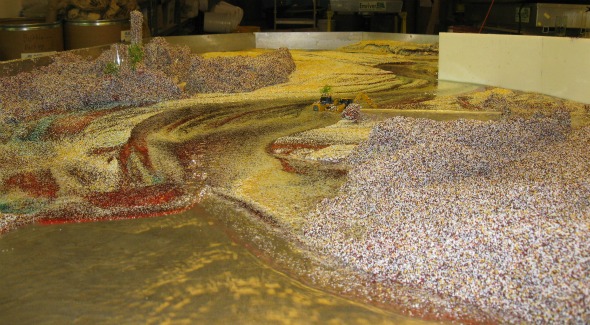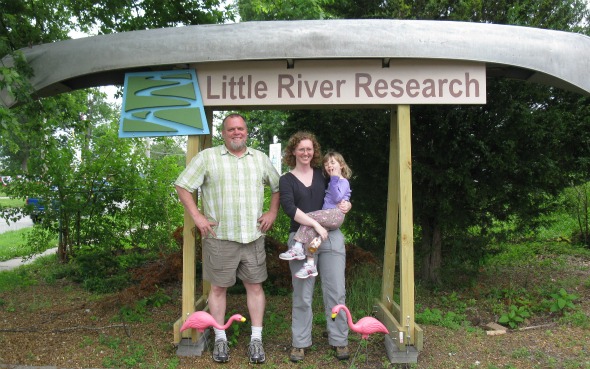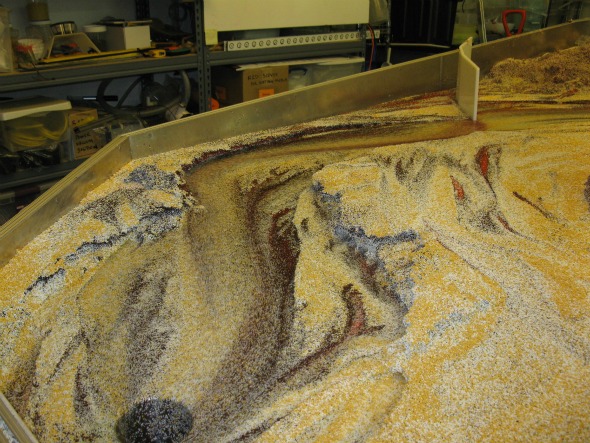![]() I’ve got a shiny new Emriver Em2 river processes simulator (i.e., stream table), thanks to departmental equipment funds and enthusiastic colleagues. I’ve been on sabbatical this semester and away from campus, so I haven’t had a chance to play with it yet, but it is enticing me to return. I’ll be teaching Fluvial Processes fall semester, so I’m sure that my students and I will get plenty of chances to explore all of the nifty ways in which we can demonstrate and experiment with fluvial geomorphology. I’m also playing with ideas for using the Emriver model in my hydrogeology class in the spring. I think it will be a perfect way to demonstrate ideas of hyporheic flow, seepage erosion, and break through curves in tracer tests. I think my colleagues are planning to use it in sedimentology, geomorphology and hydrology classes, and one colleague may take it with him when he does outreach activities. I’m sure we will come up with even more uses for it once we get started.
I’ve got a shiny new Emriver Em2 river processes simulator (i.e., stream table), thanks to departmental equipment funds and enthusiastic colleagues. I’ve been on sabbatical this semester and away from campus, so I haven’t had a chance to play with it yet, but it is enticing me to return. I’ll be teaching Fluvial Processes fall semester, so I’m sure that my students and I will get plenty of chances to explore all of the nifty ways in which we can demonstrate and experiment with fluvial geomorphology. I’m also playing with ideas for using the Emriver model in my hydrogeology class in the spring. I think it will be a perfect way to demonstrate ideas of hyporheic flow, seepage erosion, and break through curves in tracer tests. I think my colleagues are planning to use it in sedimentology, geomorphology and hydrology classes, and one colleague may take it with him when he does outreach activities. I’m sure we will come up with even more uses for it once we get started.

Em4 model at work in promoting discussion about whether the arrow points to a good place to build a house.
My appetite for experiment with the stream table was whetted by a recent visit to Carbondale, Illinois and the base of operations for Little River Research and Design (LRRD). Steve Gough is the owner of LRRD, the mastermind behind the Emriver models, and a genuinely fantastically nice person. Motivated by the idea that hands on education about stream processes is the best way to instill respect for and promote protection of streams and rivers, Steve has poured himself into making the best stream table on the market, and making it affordable enough to for people like me to get their hands on.
Personally, I’d always been somewhat underwhelmed by teaching- and demonstration-grade stream tables before seeing the Emriver ones. Partly it was because I’d seen and read about big research flumes, like those at the St. Anthony Falls Lab and Johns Hopkins. But another part of it was that every time I had a chance to play with a home-built stream table I was frustrated by what it couldn’t do. Principally, most stream tables don’t do a very good job of reproducing the meandering behavior of lowland streams. This has even been an area of active and high profile research in the fluvial geomorphology community. Steve’s use of low density plastic beads instead of quartz sand solves that problem pretty nicely, though there’s definitely still some braiding going on.
In addition to the 2-m long Em2 model that I have, LRRD also makes an extremely cool and versatile 4-m long model Em4. With beads colored by size, you can see (and measure) the sorting and selective transport of sediments. You can tilt the table laterally – simulating differential uplift/subsidence across the basin. There’s even a groundwater feed and extraction system! This model is pretty much as cool as I can imagine – at least short of the big research flumes mentioned above.
I can personally attest that this stream table model has the versatility to entrance both a PhD and a preschooler for more than two hours…and the preschooler wanted to go back the next day! Below I’ve added some shots of the Em4 in action. What geomorphic processes do you see?

Looking dowstream, I see a transition from "bedrock" to alluvial substrate, a really nice train of standing waves, meandering, a floodwall, and some sort of infrastructure project in the floodplain gone horribly wrong.






Comments (6)